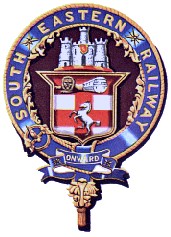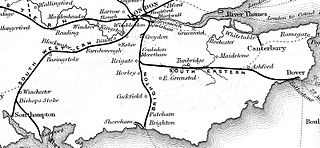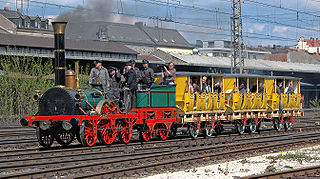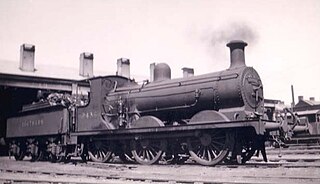
New Cross Gate is a railway station in New Cross, London, on the Brighton Main Line and the London Overground. It is 2 miles 70 chains down the line from London Bridge and is about 600 m (660 yd) west of New Cross station. It is in Travelcard Zone 2, and is operated by London Overground.

The London, Brighton and South Coast Railway was a railway company in the United Kingdom from 1846 to 1922. Its territory formed a rough triangle, with London at its apex, practically the whole coastline of Sussex as its base, and a large part of Surrey. It was bounded on its western side by the London and South Western Railway (L&SWR), which provided an alternative route to Portsmouth. On its eastern side the LB&SCR was bounded by the South Eastern Railway (SER)—later one component of the South Eastern and Chatham Railway (SE&CR)—which provided an alternative route to Bexhill, St Leonards-on-Sea, and Hastings. The LB&SCR had the most direct routes from London to the south coast seaside resorts of Brighton, Eastbourne, Worthing, Littlehampton and Bognor Regis, and to the ports of Newhaven and Shoreham-by-Sea. It served the inland towns and cities of Chichester, Horsham, East Grinstead and Lewes, and jointly served Croydon, Tunbridge Wells, Dorking and Guildford. At the London end was a complicated suburban and outer-suburban network of lines emanating from London Bridge and Victoria, and shared interests in two cross-London lines.

The South Eastern Railway (SER) was a railway company in south-eastern England from 1836 until 1922. The company was formed to construct a route from London to Dover. Branch lines were later opened to Tunbridge Wells, Hastings, Canterbury and other places in Kent. The SER absorbed or leased other railways, some older than itself, including the London and Greenwich Railway and the Canterbury and Whitstable Railway. Most of the company's routes were in Kent, eastern Sussex and the London suburbs, with a long cross-country route from Redhill in Surrey to Reading, Berkshire.
The London and Croydon Railway (L&CR) was an early railway in England. It opened in 1839 and in February 1846 merged with other railways to form the London Brighton and South Coast Railway (LB&SCR).

The London and Brighton Railway (L&BR) was a railway company in England which was incorporated in 1837 and survived until 1846. Its railway ran from a junction with the London & Croydon Railway (L&CR) at Norwood – which gives it access from London Bridge, just south of the River Thames in central London. It ran from Norwood to the South Coast at Brighton, together with a branch to Shoreham-by-Sea.

Under the Whyte notation for the classification of steam locomotives, 2-2-2 represents the wheel arrangement of two leading wheels on one axle, two powered driving wheels on one axle, and two trailing wheels on one axle. The wheel arrangement both provided more stability and enabled a larger firebox than the earlier 0-2-2 and 2-2-0 types. This configuration was introduced in 1834 on Robert Stephenson's 'Patentee locomotive' but it was later popularly named Jenny Lind, after the Jenny Lind locomotive which in turn was named after the popular singer. They were also sometimes described as Singles, although this name could be used to describe any kind of locomotive with a single pair of driving wheels.
William Stroudley was an English railway engineer, and was one of the most famous steam locomotive engineers of the nineteenth century, working principally for the London, Brighton and South Coast Railway (LB&SCR). He designed some of the most famous and longest-lived steam locomotives of his era, several of which have been preserved.

Brighton railway works was one of the earliest railway-owned locomotive repair works, founded in 1840 by the London and Brighton Railway in Brighton, England, and thus pre-dating the more famous railway works at Crewe, Doncaster and Swindon. The works grew steadily between 1841 and 1900 but efficient operation was always hampered by the restricted site, and there were several plans to close it and move the facility elsewhere. Nevertheless, between 1852 and 1957 more than 1200 steam locomotives as well as prototype diesel electric and electric locomotives were constructed there, before the eventual closure of the facility in 1962.

The London, Brighton and South Coast Railway C2 class was a class of 0-6-0 steam locomotives, intended for heavy freight trains. Fifty-five were built by the Vulcan Foundry between 1893 and 1902 to the design of Robert J. Billinton. Forty-five of these were later rebuilt between 1908 and 1940, with a larger boiler as the C2X class.
Thomas Kirtley was an English railway engineer, and was the locomotive superintendent of the North Midland Railway and later the London, Brighton and South Coast Railway.

The London, Brighton and South Coast Railway E3 Class were 0-6-2T side tank steam locomotives. One prototype was designed by William Stroudley shortly before his death, but was completed by R. J. Billinton, who later built sixteen further locomotives.

John Chester Craven was an English locomotive engineer. He was the locomotive, carriage and wagon superintendent of the London, Brighton and South Coast Railway from 1847 until his resignation in 1870. He died in 1887.
George Forrester and Company was a British marine engine and locomotive manufacturer at Vauxhall Foundry in Liverpool, established by Scottish engineer George Forrester. The company opened in 1827 as iron founders and commenced building steam locomotives in 1834.

The LB&SCR Richmond class, 0-4-2 express passenger locomotives, were designed by William Stroudley of the London Brighton and South Coast Railway in 1877. They were a larger version of his "Lyons" class (D2) which were in turn developed from his successful "D-tank" class of 1873.

The LB&SCR Belgravia class, were 2-4-0 passenger locomotives designed by William Stroudley of the London Brighton and South Coast Railway (LB&SCR) in 1872 for secondary passenger duties.

The London, Brighton and South Coast Railway (LB&SCR) C class was a type of 0-6-0 freight steam locomotive designed by William Stroudley.

John Gray was an early English steam locomotive engineer who introduced several innovations in locomotive design during the 1830s and 1840s. John Gray's origins were thought to be unknown but he appears to have originated from Newcastle. John Gray was born 29 August 1810 in Newcastle upon Tyne, Northumberland, England.
James I'Anson Cudworth was an English railway engineer, and was Locomotive Superintendent of the South Eastern Railway (SER). He served in this capacity from 1845 to 1876. He is notable for designing a successful method for burning coal in steam locomotives without significant emission of smoke, and for introducing the 0-4-4T wheel arrangement to English railways.

Bricklayers Arms was a railway station in Southwark opened by the London and Croydon Railway and the South Eastern Railway in 1844 as an alternative to the London and Greenwich Railway's terminus at London Bridge. The station was at the end of a short branch line from the main line to London Bridge and served as a passenger terminus for a few years before being converted to a goods station and engineering facility. The goods station closed in 1981.














